

How to Make Cannabis Coconut Oil
A simple and straightforward beginner’s guide to making cannabis coconut oil at home. This dairy-free and plant-based cannabis cooking medium can be used to transform your favourite recipes into cannabis edible recipes! This article will teach you how to make cannabis coconut oil, which ingredients and equipment you need, the different types of oil, how to calculate the potency of the oil, and more!
Cannabis coconut oil is one of the most versatile and adaptable cooking mediums available when trying to make cannabis edibles. This oil can be used to substitute cooking oil in many recipes or used as an alternative to cannabis butter. The only limit is your imagination.
This is a base ingredient, meaning you use this to make more specific recipes such as weed gummy bears, weed chocolate cake, vegan pot brownies and many more!
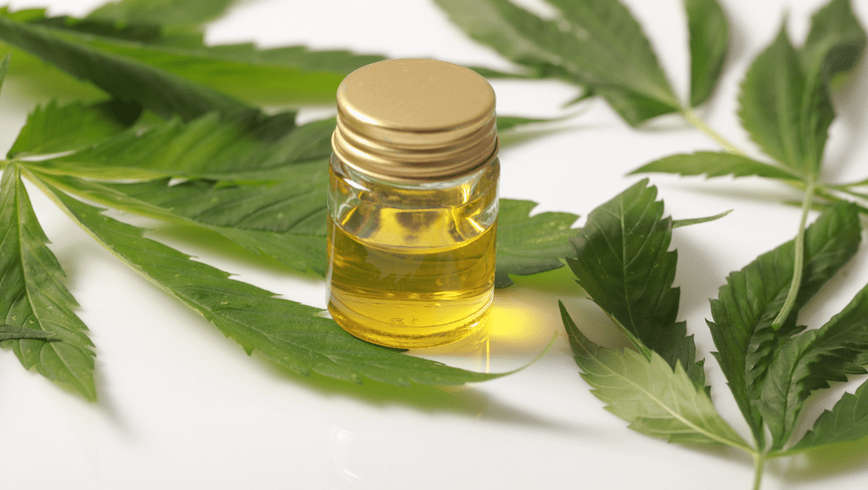
What Type of Coconut Oil Should I Use?
When buying the ingredients to make this infused recipe, you will come across many different types of coconut oil. This means you will have to pick which one you want to use. The main three types are unrefined, refined, and MCT coconut oil.
Each type of oil is processed and made slightly different, but the infusion will work with any type you choose. We use organic virgin unrefined coconut oil for this recipe, but you can use whichever type you prefer.
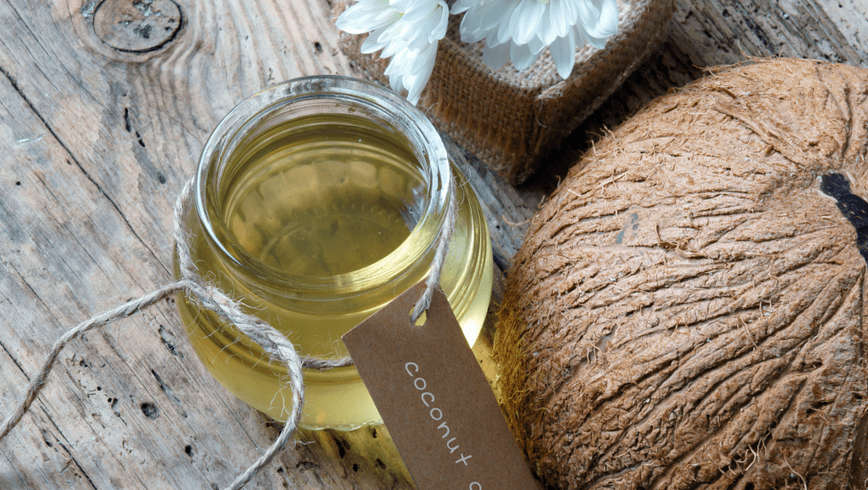
Virgin or Unrefined Coconut Oil
This is the least processed form of coconut oil available. The oil is extracted from fresh coconuts using a centrifuge and undergoes no bleaching. This results in the oil having a stronger coconut flavour than the other types while also retaining more nutrients.
This is the organic virgin unrefined coconut oil we recommend!
The process to get refined coconut oil is more unnatural. The oil is first “dry milled”, this means the coconuts are baked prior to extracting the oil from them. Then the oil is either “bleached” to kill off microbes, dust particles, and insects or steamed to refine the oil further. This type of oil has a less prominent coconut flavour which makes it more compatible with recipes.
This is the organic refined coconut oil we recommend!
Medium-chain triglyceride (MCT) oil is a type of fat extracted from coconuts that are known for their unique health benefits. These are easily digested and metabolized into the body allowing for an immediate source of energy. This liquid oil is preferred by many individuals because it is tasteless and has many health benefits.
This is the MCT oil we recommend!
The Importance of Decarboxylation
The first step to making cannabis coconut oil is decarboxylating your cannabis. Learning how to decarboxylate cannabis properly is a critical step when making edibles. It will increase the potency of the edibles and allow you to maximize the results. If you were to consume cannabis raw, there would be no psychoactive effects.
Decarboxylation is important because it will turn the THC-A molecule into the psychoactive THC molecule. When you smoke cannabis, this chemical reaction would already be happening naturally when you ignite it. When making edibles, there is no cannabis being burned. Therefore, we need to do this extra step when making cannabis coconut oil and other cannabis cooking mediums.
How to Decarboxylate
Since we know that decarboxylation is the process by which the THC-A molecule transforms into the psychoactive THC molecule, we are going to replicate this transformation using an oven. Instead of burning, we’re going to be heating the cannabis up to a certain temperature. This process also happens naturally when you vape cannabis.
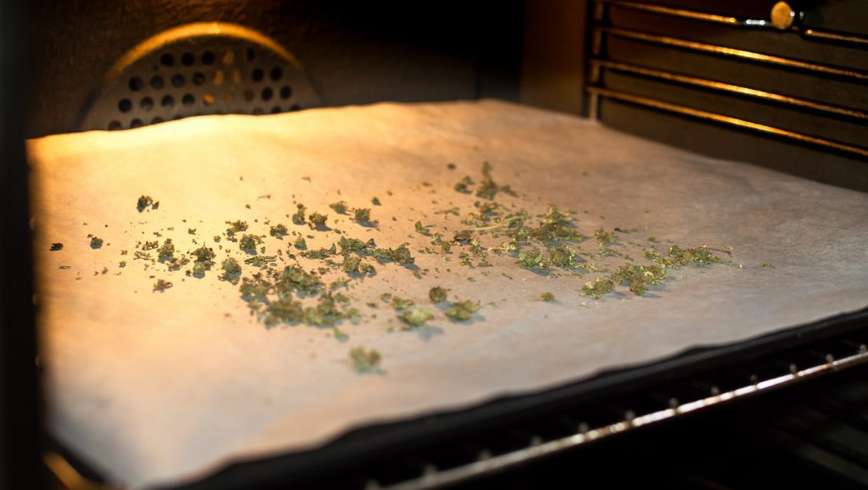
We recommend baking the cannabis in the oven at 240 Fahrenheit for 60 minutes. This is the temperature and time we have found to be most optimal. If you don’t know how to decarboxylate or want to learn more, we have already written a comprehensive guide to decarboxylating cannabis here.
Best Temperature to Activate Cannabis
Here is a table with the results of a cannabis decarboxylation experiment. As you can see below, the optimal time to get the most THC and CBD is 60 minutes.
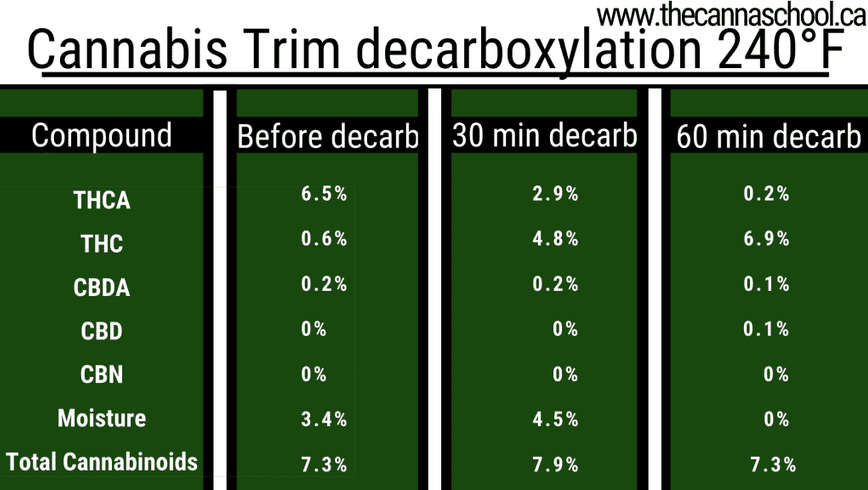
cannabis trim decarboxylation at 240 degrees Fahrenheit
Dosage Guide to Cannabis Coconut Oil
Learning how to calculate and estimate the potency of your cannabis coconut oil is crucial. Once you know the potency, you will be able to adjust each recipe so it contains the dosage you prefer. Furthermore, you can alter the recipe the coconut oil is used in so each serving has the amount of THC you want.
Knowing the potency is important because some recipes are going to require more coconut oil than others. Therefore you might need to substitute in some regular coconut oil to reduce the potency. You will only know how much to substitute if you have the potency already measured.
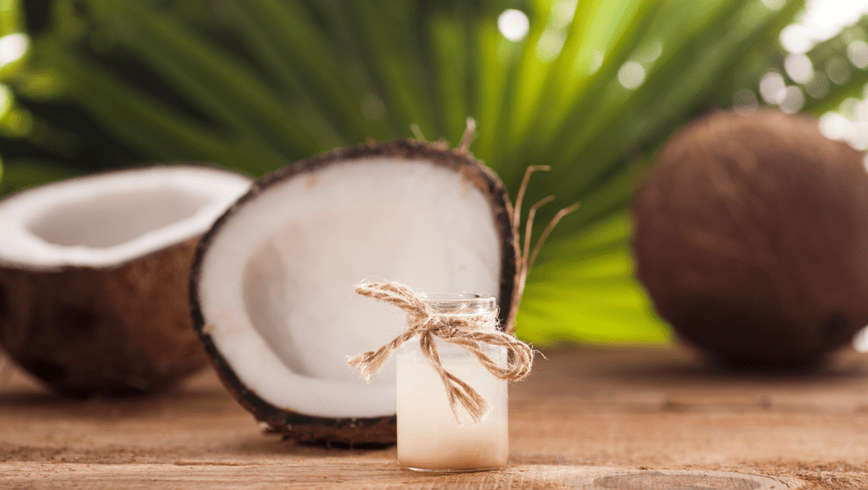
How to Calculate Potency of Cannabis Coconut Oil
To calculate the potency of the cannabis coconut oil, you will need to know a few main variables. These variables include:
The amount of cannabis used for the infusion (grams)
How potent the cannabis is (THC %)
How much coconut oil was used in the infusion (cups)
Once you know these variables, you can manually input them into the potency calculator found below. You can also adjust the variables until you find a dosage you like, then you will know how much of each ingredient you need to get that dosage!
How to Change the Potency of Cannabis Coconut Oil
By adjusting the amount of each ingredient the recipe calls for, you can change how potent the cannabis coconut oil is going to be. There are three variables you can change that will alter the potency of the final product.
You can either add more coconut oil to the recipe (less potent), or remove some coconut oil (more potent)
Another option is to add more cannabis to the recipe (more potent), or remove some cannabis (less potent)
The last option is to use a more potent strain of cannabis (more potent), or use a less potent strain (less potent)
You can see how each change affects the recipe by using the potency calculator found below. Furthermore, there is flexibility with the recipe.
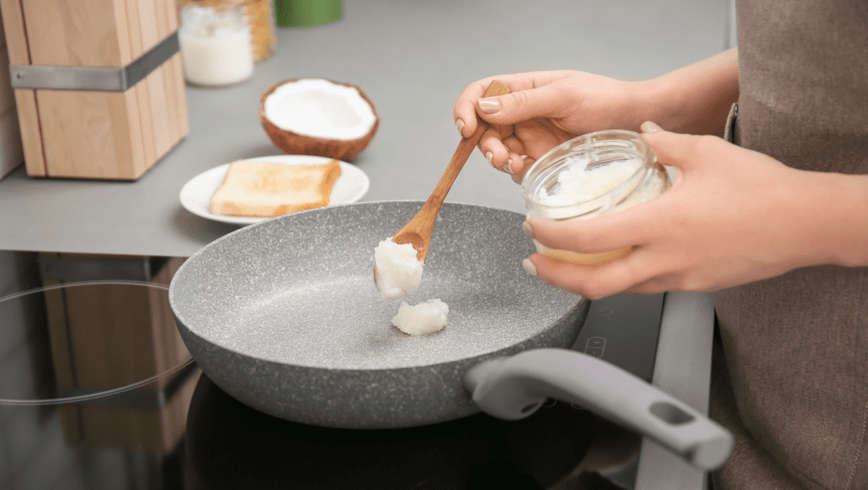
Potency Calculator
This dosage calculator will automatically update when you fill out your own values. It will work for both kief and cannabis flowers. Once you know the potency of the cannabis coconut oil, you will be able to calculate the potency of each recipe you make with it. This will help you decide how much cannabis coconut oil is needed to get your preferred dosage.
What You Need to Make Cannabis Coconut Oil
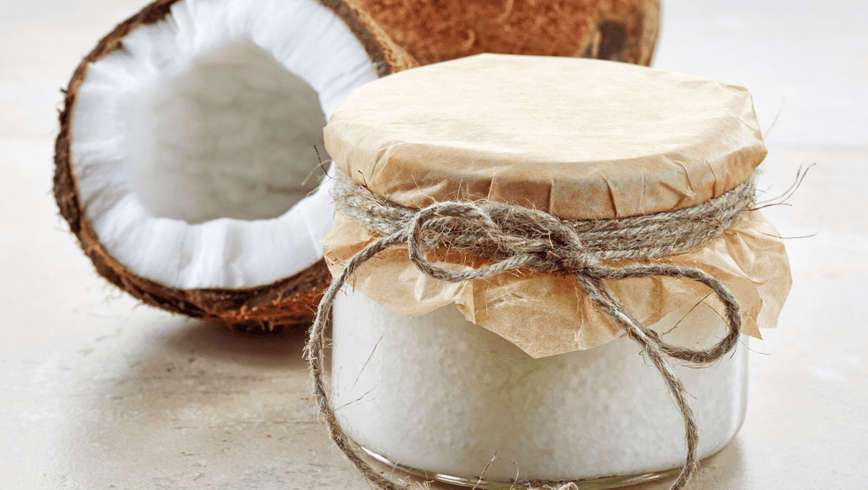
To make cannabis coconut oil you will only need a few main ingredients and some cooking equipment. These can easily be found at your local grocery store or online with the exception of cannabis.
Ingredients needed:
1 ounce of cannabis bud
Equipment needed:
Cannabis Coconut Oil Recipe

Cannabis Coconut Oil
A simple and straightforward beginner's guide to making cannabis coconut oil at home. This dairy-free and plant-based cannabis cooking medium can be used to transform your favourite recipes into cannabis edible recipes!

Equipment
- Tea Towel
- Crockpot
- Mason Jars
- Oven
- Baking Sheet
- Paper towel
- Cheesecloth
Ingredients
Instructions
- 1Step 1
First, prepare the crockpot. Lay a clean tea towel down at the bottom of the crockpot to create a small buffer. This will help secure the mason jars during the cooking process and help prevent the glass from cracking.
- 2Step 2
Fill the crockpot with enough water to fully submerge the mason jars. Aim to have an inch of water covering the top lids.
- 3Step 3
Turn the crockpot to high heat until it reaches 185 Fahrenheit (85 Celsius), then turn it to low heat.
- 4Step 4
While the crockpot heats up the water, line a baking sheet with parchment paper. Spread the ground cannabis bud evenly on the sheet. Bake in the oven at 240 Fahrenheit (115 Celsius) for 60 minutes.
- 5Step 5
Divide the coconut oil evenly into the mason jars. Make sure to leave a 1/2 inch space at the top of each one, you will need room for the decarboxylated cannabis.
- 6Step 6
Divide the decarboxylated cannabis evenly into the coconut oil filled mason jars. Clean the rim of the jars with paper towel to make them less slippery. Place the lid on each jar and tighten the metal ring around each one with your hands.
- 7Step 7
Place the mason jars in the water-filled crockpot carefully. Close the lid of the crockpot and cook for 4 hours.
- 8Step 8
After the time is up, carefully remove the mason jars from the crockpot and allow them to cool. Once they have cooled enough to handle, strain the cannabis coconut oil through a cheesecloth into the jar you're storing the oil in. The cheesecloth helps to separate the plant-matter from the oil.
- 9Step 9
Store the coconut oil in a cool dry location. We recommend storing it in the refrigerator for best results. You may also freeze it for longer storage.
Recipe notes
If using a refrigerator or freezer, never heat up the oil using a microwave, this may diminish some of the cannabinoids. If the mason jars are floating, place an object that's heat and water safe over top of the jar to weigh it down. We recommend just using a clean rock. Sanitize the jars prior to making the recipe. Just allow them to sit in hot water for at least 10 minutes.
Nutrition
 www.thecannaschool.ca
www.thecannaschool.caCannabis Coconut Oil
A simple and straightforward beginner's guide to making cannabis coconut oil at home. This dairy-free and plant-based cannabis cooking medium can be used to transform your favourite recipes into cannabis edible recipes!
Ingredients
- 16 ounces virgin unrefined coconut oil
- 1 ounce cannabis bud
Instructions
1. First, prepare the crockpot. Lay a clean tea towel down at the bottom of the crockpot to create a small buffer. This will help secure the mason jars during the cooking process and help prevent the glass from cracking.
2. Fill the crockpot with enough water to fully submerge the mason jars. Aim to have an inch of water covering the top lids.
3. Turn the crockpot to high heat until it reaches 185 Fahrenheit (85 Celsius), then turn it to low heat.
4. While the crockpot heats up the water, line a baking sheet with parchment paper. Spread the ground cannabis bud evenly on the sheet. Bake in the oven at 240 Fahrenheit (115 Celsius) for 60 minutes.
5. Divide the coconut oil evenly into the mason jars. Make sure to leave a 1/2 inch space at the top of each one, you will need room for the decarboxylated cannabis.
6. Divide the decarboxylated cannabis evenly into the coconut oil filled mason jars. Clean the rim of the jars with paper towel to make them less slippery. Place the lid on each jar and tighten the metal ring around each one with your hands.
7. Place the mason jars in the water-filled crockpot carefully. Close the lid of the crockpot and cook for 4 hours.
8. After the time is up, carefully remove the mason jars from the crockpot and allow them to cool. Once they have cooled enough to handle, strain the cannabis coconut oil through a cheesecloth into the jar you're storing the oil in. The cheesecloth helps to separate the plant-matter from the oil.
9. Store the coconut oil in a cool dry location. We recommend storing it in the refrigerator for best results. You may also freeze it for longer storage.
Recipe notes
If using a refrigerator or freezer, never heat up the oil using a microwave, this may diminish some of the cannabinoids. If the mason jars are floating, place an object that's heat and water safe over top of the jar to weigh it down. We recommend just using a clean rock. Sanitize the jars prior to making the recipe. Just allow them to sit in hot water for at least 10 minutes.

Jake Randall is a journalist, author, and University of Guelph Alumni with expertise in all things cannabis, along with knowledge in economics, the environment, and everything in between. Originally from just outside Toronto Canada, Jake has taken on the role of a senior cannabis correspondent at The Cannabis School.
Comments
QUESTION: can weed be decarbed directly in coconut oil? the oil and cannabis are put in a glass container, put in a preheated oven 240F for 60 minutes. if not, how is decarbing on a cooking sheet chemically different than decarbing in oil?
I find dispensaries lie about the percentage of THC in CBD that's in the weed that you purchase. I have dun my own test using a purple delta tester. It's +-2%
The recipe call for one ounce of weed. The dispensary I buy from sells in 1/8 ounce containers, which is about 3.5 grams. I assume you did not mean one gram, right? Or did you mean one gram?
When making the Cannibis coconut oil recipe, why am I doing the decarboxylation process for 40 min @240 degrees when the chart above said do the decarboxylation process for 60min @240 degrees? And can the strained bud in the cheesecloth still be used for something else?
How do I find what’s the THC and CBD content of the weed I have? I have OG Kush and Purple Kush
Hi Patrick, if you purchased the cannabis from a dispensary, it should have the THC and CBD content labelled. However, if you got it elsewhere, your best bet would be to look up the THC and CBD ranges for those specific strains online. Unfortunately, you're going to have a hard time finding the exact cannabinoid percentages if it isn't already labelled. Hope this helps!
Thanks Jake, I appreciate it. I’ll have to look it up online. I hope to find some good dispensaries out in LA when I visit in a couple months. So I’ll know exactly. Thanks again.
Add a comment
This will be publicly visible.
Your email address will not be published.
Your comment will be reviewed by the admin before it is published.



